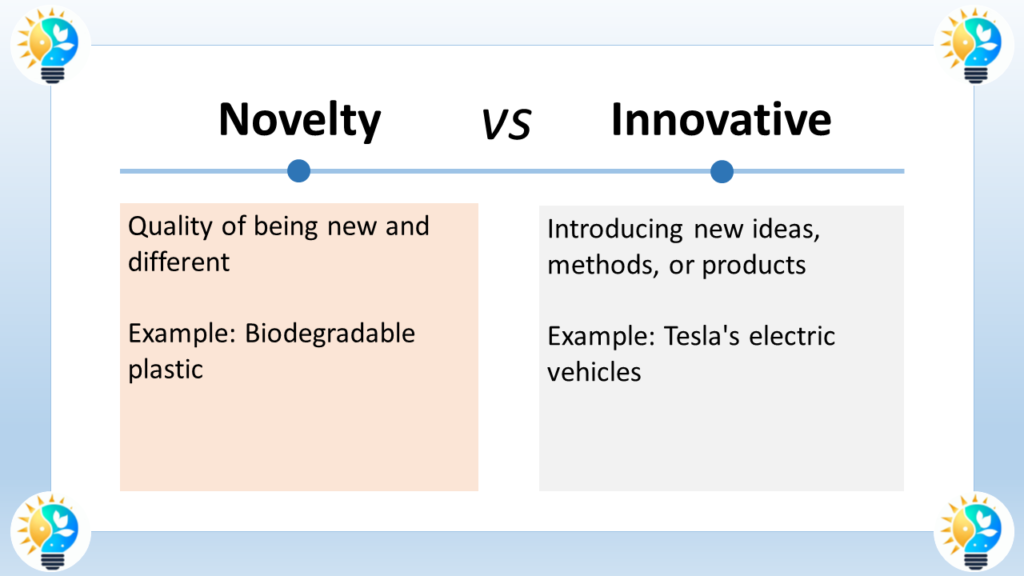Both terms involve newness and originality
“innovative” implies a practical application or implementation of new ideas,
“novelty” can refer to more superficial or temporary innovations.

When it comes to new ideas, methods, or products, two terms often come to mind: “innovative” and “novelty.” However, these two words have distinct meanings and implications.
Definitions
Innovative
An innovative concept is characterized by the introduction of new ideas, methods, or products that not only bring something new but also offer improvement or solve problems in a way that was not done before. It’s not just new, but it also brings functional improvements, efficiencies, or advancements.
For example, an innovative piece of technology would not only be the latest release but also offer new functionality or efficiencies that previous versions or products did not. The emphasis is on the practical application of new ideas or techniques, and the impact they have on advancing a field or improving a situation.
Novelty
On the other hand, “novelty” refers to the state or quality of being new, unusual, or unique, often without any judgment regarding its value or utility. A novelty item might be interesting or amusing due to its uniqueness, but it doesn’t necessarily bring functional improvements or practical changes.
For instance, a novelty gift might be something like a mug with a quirky design. It’s unique and possibly entertaining, but it doesn’t necessarily improve upon the concept of a mug.
What is the difference between Novelty and Innovation?
What is the difference between Innovative Technology and Novel Tech?
Innovative Terms

Innovation is considered as a driving force in progress.
It includes the introduction of novel ideas, methods, or products that bring positive change and advancement.
For more information about innovations, check our glossary
The Key Difference between Innovation and Novelty
Difference
Innovation and novelty are often used interchangeably, but they have distinct differences:
- Innovation refers to creating something new that has value and solves a problem, leading to significant change or improvement. It involves taking existing ideas and improving upon them to create something new and better.
- Novelty, on the other hand, is simply the state of being new or unique, but not necessarily useful or valuable. It can be a new product, idea, or trend that lacks substance and practical applications.
In summary, innovation creates value and drives progress and growth, while novelty is merely something new or unusual without substantial impact4.It is crucial to understand this difference as innovation is essential for driving industries forward by redefining business models and setting new standards, while novelty often represents incremental changes aimed at differentiation rather than true transformation123.
Frequently Asked Questions
Q: What is the difference between “innovative” and “novelty”?
A: “Innovative” refers to new ideas, methods, or products that bring improvement or solve problems in a way that was not done before, with a focus on utility and progress. “Novelty,” on the other hand, refers to the state or quality of being new, unusual, or unique, without necessarily implying a practical improvement or significant change.
Q: Can a product or idea be both innovative and a novelty?
A: Yes, it’s possible for a product or idea to be both innovative and a novelty. For example, a new piece of technology that has unique features and provides functional improvements would be considered both innovative and a novelty.
Q: Why is it important to understand the difference between the two terms?
A: Understanding the difference between “innovative” and “novelty” is essential for effective communication and avoiding confusion when discussing new ideas, methods, or products. It also helps in evaluating the potential impact and value of a new concept.
Q: How can I determine if something is innovative or just a novelty?
A: To determine if something is innovative or just a novelty, consider the following questions: Does it bring functional improvements or solve problems in a new way? Does it have a practical application and potential impact on a field or situation? If the answer is yes, then it’s likely innovative. If not, then it’s probably just a novelty.
Q: Is it better to be innovative or to offer novelty items?
A: It depends on the context and goals. If the goal is to make a meaningful impact or bring about progress in a field, then being innovative is the better option. However, if the goal is to provide entertainment or amusement, then offering novelty items might be more appropriate. Ultimately, the decision should be based on the intended audience and purpose.
- [1] Apex International – Innovation versus Novelty: Know the Difference
- [2] LinkedIn – What’s the Difference Between Novelty and Innovation?
- [3] ThoughtWorks – Why Enterprise Needs Lean Product Development
- [4] The Content Authority – Innovation vs Novelty
- [5] The Innovation Mode – How Novelty is Important to Innovation


